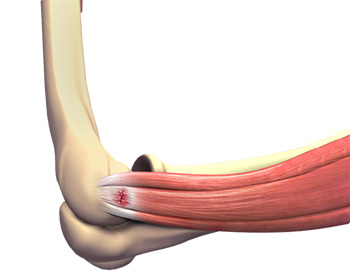Tennis Elbow

Tennis elbow is the common name used for the elbow condition called lateral epicondylitis. It is an overuse injury that causes inflammation of the tendons that attach to the bony prominence on the outside of the elbow (lateral epicondyle). It is a painful condition occurring from repeated muscle contractions at the forearm that leads to inflammation and micro tears in the tendons that attach to the lateral epicondyle. The condition is more common in sports activities such as tennis, painting, hammering, typing, gardening and playing musical instruments. Patients with tennis elbow experience elbow pain or burning that gradually worsens and a weakened grip
Your doctor will evaluate tennis elbow by reviewing your medical history, performing a thorough physical examination and ordering X-rays, MRI or electromyogram (EMG) to detect any nerve compression.
Your doctor will first recommend conservative treatment options to treat the tennis elbow symptoms. These may include:
- Limit use and rest the arm from activities that worsen symptoms.
- Splints or braces may be ordered to decrease stress on the injured tissues.
- Apply ice packs on the elbow to reduce swelling.
- Avoid activities that bring on the symptoms and increase stress on the tendons.
- Anti-inflammatory medications and/or steroid injections may be ordered to treat pain and swelling.
- Physical therapy may be ordered for strengthening and stretching exercises to the forearm once your symptoms have decreased.
- Pulsed ultrasound may be utilized to increase blood flow and promote healing to the injured tendons.
If conservative treatment options fail to resolve the condition and symptoms persist for 6 -12 months, your surgeon may recommend a surgical procedure to treat tennis elbow called lateral epicondyle release surgery. Your surgeon will decide whether to perform your surgery in the traditional open manner (single large incision) or endoscopically (2 to 3 tiny incisions and the use of an endoscope –narrow lighted tube with a camera). Your surgeon will decide which options are best for you depending on your specific circumstances.
Your surgeon moves aside soft tissue to view the extensor tendon and its attachment on the lateral epicondyle. The surgeon then trims the tendon or releases the tendon and then reattaches it to the bone. Any scar tissue present will be removed as well as any bone spurs. After the surgery is completed, the incision(s) are closed by suturing or by tape.
Xu Q, Chen J, Cheng L.
Int J Surg. 2019 May 22. pii: S1743-9191(19)30106-2. doi: 10.1016/j.ijsu.2019.05.003.
"RESULTS: A total of seven randomized controlled trials (RCTs) involving 515 patients were finally included in our study. The present meta-analysis indicated that PRP [platelet-rich plasma] injection yielded statistically significant superior in pain scores and elbow joint function at a 6-month follow up compared with local corticosteroid injection. No significant difference was identified between two groups regarding the post-injection adverse events.
CONCLUSION: Local PRP injections was associated with superior outcomes for reducing pain and improving elbow joint function compared with local corticosteroids treatment for LE at a follow-up of 6 months.”
Following surgery, you are referred to physical therapy to improve the range of motion and strength of your joint.
DISCLAIMER: Following information is for demonstration purposes and for understanding of the basic idea and concept of the procedure. The actual procedure may differ and may not be the same. This website does not take any responsibility for authenticity of videos/ information leaflet.
Please go through the benefits, risks and rehabilitation of the procedure fully before consenting.
 Recover - Tennis Elbow Patient Information
Recover - Tennis Elbow Patient Information
You will need the Adobe Reader to view and print the above documents. ![]()
